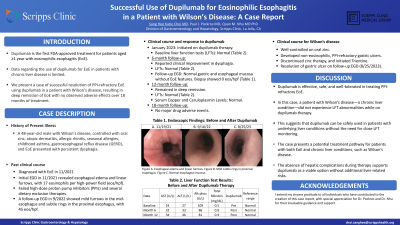Sunday Poster Session
Category: Esophagus
P0600 - Successful Use of Dupilumab for Eosinophilic Esophagitis in a Patient With Wilson’s Disease
Sunday, October 27, 2024
3:30 PM - 7:00 PM ET
Location: Exhibit Hall E

Has Audio

Sang Hee K. Choi, MD
Scripps Clinic
San Diego, CA
Presenting Author(s)
Sang Hee Choi, MD1, Paul J. Pockros, MD1, Quan Nhu, MD, PhD2
1Scripps Clinic, San Diego, CA; 2Scripps Clinic, La Jolla, CA
Introduction: Dupilumab is the first FDA-approved treatment for patients aged ≥1 year with eosinophilic esophagitis (EoE). There is limited data regarding the use of dupilumab for EoE in patients with chronic liver diseases, including Wilson’s disease. We report a case of successful resolution of PPI-refractory EoE using dupilumab in a patient with Wilson’s disease, resulting in deep remission of EoE with no observed adverse effects over 18 months of treatment.
Case Description/Methods: A 48-year-old white male with Wilson’s disease, controlled with oral zinc, atopic dermatitis, allergic rhinitis, seasonal allergies, childhood asthma, gastroesophageal reflux disease, and EoE, presented with persistent dysphagia. The patient was diagnosed with EoE after an initial EGD revealed esophageal edema and linear furrows, with biopsies showing 17 eosinophils per high-power field (eos/hpf). Despite high-dose proton pump inhibitors (PPIs) and several dietary exclusion therapies, the patient continued to experience dysphagia with persistent EoE features of mid-esophageal edema and linear furrows on subsequent EGDs, with variable esophageal eosinophil counts on repeat biopsies reaching 45 eos/hpf.
While on oral zinc for Wilson’s disease, the patient developed persistent non-eosinophilic PPI-refractory gastric ulcers, leading to the discontinuation of zinc therapy. Trientine was initiated for Wilson’s disease due to these gastric ulcers.
For PPI-refractory EoE, the patient was started on dupilumab. At the 6-month follow-up, he reported clinical improvement in dysphagia. Liver function tests (LFTs), serum copper, and ceruloplasmin levels remained normal while on dupilumab. Follow-up EGD showed normal gastric and esophageal mucosa without EoE features, and esophageal biopsies were devoid of eosinophils. The patient had sustained deep remission of EoE over 18 months of dupilumab treatment, with no major drug adverse effects.
Discussion: Currently, there is no existing data to guide the use of dupilumab for EoE in patients with Wilson’s disease. This case demonstrates that dupilumab is effective, safe, and well-tolerated in treating PPI-refractory EoE without causing liver function test abnormalities, even in a patient with a chronic liver condition such as Wilson’s disease. Our case provides further support that close monitoring of LFTs during dupilumab therapy is not required. This case report is significant as it provides a potential treatment pathway for similar patients with concurrent EoE and Wilson’s disease.
Disclosures:
Sang Hee Choi, MD1, Paul J. Pockros, MD1, Quan Nhu, MD, PhD2. P0600 - Successful Use of Dupilumab for Eosinophilic Esophagitis in a Patient With Wilson’s Disease, ACG 2024 Annual Scientific Meeting Abstracts. Philadelphia, PA: American College of Gastroenterology.
1Scripps Clinic, San Diego, CA; 2Scripps Clinic, La Jolla, CA
Introduction: Dupilumab is the first FDA-approved treatment for patients aged ≥1 year with eosinophilic esophagitis (EoE). There is limited data regarding the use of dupilumab for EoE in patients with chronic liver diseases, including Wilson’s disease. We report a case of successful resolution of PPI-refractory EoE using dupilumab in a patient with Wilson’s disease, resulting in deep remission of EoE with no observed adverse effects over 18 months of treatment.
Case Description/Methods: A 48-year-old white male with Wilson’s disease, controlled with oral zinc, atopic dermatitis, allergic rhinitis, seasonal allergies, childhood asthma, gastroesophageal reflux disease, and EoE, presented with persistent dysphagia. The patient was diagnosed with EoE after an initial EGD revealed esophageal edema and linear furrows, with biopsies showing 17 eosinophils per high-power field (eos/hpf). Despite high-dose proton pump inhibitors (PPIs) and several dietary exclusion therapies, the patient continued to experience dysphagia with persistent EoE features of mid-esophageal edema and linear furrows on subsequent EGDs, with variable esophageal eosinophil counts on repeat biopsies reaching 45 eos/hpf.
While on oral zinc for Wilson’s disease, the patient developed persistent non-eosinophilic PPI-refractory gastric ulcers, leading to the discontinuation of zinc therapy. Trientine was initiated for Wilson’s disease due to these gastric ulcers.
For PPI-refractory EoE, the patient was started on dupilumab. At the 6-month follow-up, he reported clinical improvement in dysphagia. Liver function tests (LFTs), serum copper, and ceruloplasmin levels remained normal while on dupilumab. Follow-up EGD showed normal gastric and esophageal mucosa without EoE features, and esophageal biopsies were devoid of eosinophils. The patient had sustained deep remission of EoE over 18 months of dupilumab treatment, with no major drug adverse effects.
Discussion: Currently, there is no existing data to guide the use of dupilumab for EoE in patients with Wilson’s disease. This case demonstrates that dupilumab is effective, safe, and well-tolerated in treating PPI-refractory EoE without causing liver function test abnormalities, even in a patient with a chronic liver condition such as Wilson’s disease. Our case provides further support that close monitoring of LFTs during dupilumab therapy is not required. This case report is significant as it provides a potential treatment pathway for similar patients with concurrent EoE and Wilson’s disease.
Disclosures:
Sang Hee Choi indicated no relevant financial relationships.
Paul Pockros: ChemoMab – Grant/Research Support. Gilead – Advisory Committee/Board Member, Grant/Research Support, Speakers Bureau. Intercept – Advisor or Review Panel Member, Grant/Research Support, Speakers Bureau. Ipsen – Speakers Bureau. Orphalan – Advisory Committee/Board Member. Up To Date – Royalties.
Quan Nhu: Regeneron – Advisory Committee/Board Member, Speakers Bureau. Sanofi – Advisory Committee/Board Member, Speakers Bureau. Takeda – Advisory Committee/Board Member.
Sang Hee Choi, MD1, Paul J. Pockros, MD1, Quan Nhu, MD, PhD2. P0600 - Successful Use of Dupilumab for Eosinophilic Esophagitis in a Patient With Wilson’s Disease, ACG 2024 Annual Scientific Meeting Abstracts. Philadelphia, PA: American College of Gastroenterology.

